|
Introduction
This academic year 2006-2007 was a year of continued
growth for the Orthopaedic Department at Children’s Hospital
Boston. We added three new staff in our clinical program, a
new director of basic science research, and established a major
new site of service in Waltham. In doing this, as always, we
strengthened our teaching program for the residents, fellows,
and students, as well as providing greater opportunity for
clinical practice for the staff. In addition to the normal daily
conferences providing the bulk of our teaching program, Grice
Day in the fall and a festschrift in honor of Dr. Glimcher were
highlights of our teaching program.
Our clinical program grew at over 3% last year, which was
quite a feat. This was really secondary to the addition of three
staff members; Dr. Gregory Melkonian, Dr. Travis Matheney,
and Dr. Samantha Spencer. Samantha Spencer did her undergraduate
work and attended medical school at the University
of Michigan prior to coming to the Harvard Combined
Orthopaedic Residency Program. After completing residency
and fellowship with us, she joined the staff with a special interest
in metabolic bone disease, bone dysplasias, and osteogenesis
imperfecta. She spent time visiting Francois Fassier in
Montreal, enhancing her education in osteogenesis imperfecta
in both medical and surgical treatment. Travis Matheney was a
medical student at Dartmouth prior to coming to the Harvard
Orthopaedic Program. After expressing an interest in pediatric
orthopaedics, cerebral palsy and hip problems, he entered the
fellowship program here at Children’s. He supplemented his
education with a trip to Australia and New Zealand visiting Kerr
Graham, Hamish Crawford and Rich Nichol. I am certain that,
in addition to the orthopaedic perspective, he gained quite an
education while spending two months down under. Finally,
Greg Melkonian came to us from his practice in Concord, New
Hampshire. He has been by training a veterinarian and an
orthopaedic surgeon, having completed the program at the
University of Vermont. He did advanced training at Rancho Los
Amigos Hospital. He has an interest and vast experience in the
management of children with neuromuscular diseases. Susan
Mahan has completed her Masters Degree in Public Health and
has moved from part-time to full-time member of our department.
She has had a concentrated interest in epidemiology as
well as clinical research based on large database analysis.
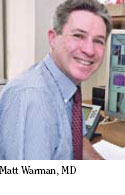 In addition to the expansion of our clinical staff, our basic
science program is developing at a rapid rate. The addition
of Dr. Matt Warman was a major step, of which I am quite
proud. After an internal review of our
laboratory, the committee felt that the
addition of expertise in Genetics and
movement in this direction from a
mineralization and bone structure lab
was critical to future funding and consistent
with the direction of musculoskeletal
science. I structured a search
in conjunction with the Department
of Genetics at Harvard Medical School
with the assistance of Dr. Phil Leder
and Dr. Cliff Tabin to find the best fit to become the director of
our lab, along with the appointment of the Ormandy Professor
of Genetics in Orthopaedic Surgery at Harvard Medical School.
Without a doubt, Dr. Warman was the most qualified and most
exciting of the candidates interviewed and joined our staff this
year. He is a Howard Hughes investigator who had previously
worked with me in the Bone Dysplasia Clinic in the 1980s and
early 90s prior to leaving Harvard for Case Western Reserve
University. He returns with a national reputation for his expertise
in musculoskeletal genetics with great enthusiasm to move
the lab forward. Both Dr. Glimcher and I welcome him into his
new role in the lab.
In addition to the expansion of our clinical staff, our basic
science program is developing at a rapid rate. The addition
of Dr. Matt Warman was a major step, of which I am quite
proud. After an internal review of our
laboratory, the committee felt that the
addition of expertise in Genetics and
movement in this direction from a
mineralization and bone structure lab
was critical to future funding and consistent
with the direction of musculoskeletal
science. I structured a search
in conjunction with the Department
of Genetics at Harvard Medical School
with the assistance of Dr. Phil Leder
and Dr. Cliff Tabin to find the best fit to become the director of
our lab, along with the appointment of the Ormandy Professor
of Genetics in Orthopaedic Surgery at Harvard Medical School.
Without a doubt, Dr. Warman was the most qualified and most
exciting of the candidates interviewed and joined our staff this
year. He is a Howard Hughes investigator who had previously
worked with me in the Bone Dysplasia Clinic in the 1980s and
early 90s prior to leaving Harvard for Case Western Reserve
University. He returns with a national reputation for his expertise
in musculoskeletal genetics with great enthusiasm to move
the lab forward. Both Dr. Glimcher and I welcome him into his
new role in the lab.
Dr. Martha Murray and Dr. Young-Jo Kim have had great
success in the basic science arena over the past year. Dr. Murray
has been funded by the NIH for her work involving intraarticular
healing. She has, as many of you know, dedicated much
of her investigative career to the repair of the anterior cruciate
ligament and facilitating its healing. With significant success
in early results, she is moving forward in animal and hopefully
human studies to bring this technology into the clinical arena.
Dr. Kim was the recipient of a Kappa Delta Award this year,
along with Dr. Martha Gray and Dr. Deborah Burstein, for his
investigations in imaging of articular cartilage. Dr. Kim’s portion
of the study related to the use of MR of articular cartilage
to determine the outcome of redirectional osteotomies of the
proximal femur and acetabulum. Dr. Kim also is the recipient
of an OREF Career Development Award, which should move his
basic science career forward exponentially.
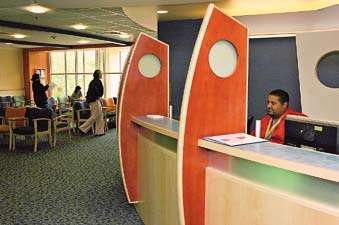
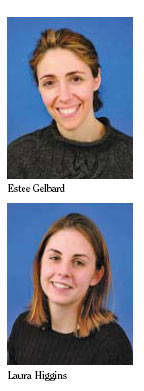 To accommodate the growing demands for pediatric
orthopaedic services, as well as deal with the congestion of the
Longwood Medical area, Children’s Hospital Boston has developed
a second site of service in Waltham, Massachusetts. The
Waltham Hospital was purchased about two years ago and has
been totally remodeled into a modern medical facility. There are
approximately 300,000 square feet of space, including an inpatient
unit, outpatient infusion unit, an ambulatory area and six
operating rooms. The orthopaedic area at Waltham consists of
7,500 square feet of exam space with a cast room and modern
state-of-the art facilities where seven doctors at one time can
see patients in high tech pods. Parking is free, which has led to
great excitement among our patients and further demands for
service in the suburbs. Sports, Hand and Upper Extremity, and
General Orthopaedics will be emphasized in this new setting,
offering a full array of ambulatory and a more limited set of
surgical services. In order to function in this new setting with
a limited number of residents and fellows, we have added two
physicians’ assistants to complement our four nurse practitioners
and provide both surgical assistance as well as pre-operative
and post-operative ambulatory
care. The physicians’ assistants, Estee
Gelbard and Laura Higgins are settling
in nicely and are both a benefit to the
clinical service as well as the educational
endeavors of the Orthopaedic
Department. While surgical assistance
by PAs may seem contrary to the educational
mission, to this point it has
significantly complemented our ability
to provide surgical care. With the PAs
working on Wednesday mornings in
the Longwood area as well as in the
Waltham unit, residents can attend
the Core Conference without clinical
demands in the hospital. In addition
to the two new physicians’ assistants
in Orthopaedics, there are two
new physicians’ assistants in Sports
Medicine, Betsy Gonski and Courtney
Peck; and four nurse practitioners in
Orthopaedics, Rachel DiFazio, Amanda Burns, Jessica Burns
and Cynthia Thompson.
To accommodate the growing demands for pediatric
orthopaedic services, as well as deal with the congestion of the
Longwood Medical area, Children’s Hospital Boston has developed
a second site of service in Waltham, Massachusetts. The
Waltham Hospital was purchased about two years ago and has
been totally remodeled into a modern medical facility. There are
approximately 300,000 square feet of space, including an inpatient
unit, outpatient infusion unit, an ambulatory area and six
operating rooms. The orthopaedic area at Waltham consists of
7,500 square feet of exam space with a cast room and modern
state-of-the art facilities where seven doctors at one time can
see patients in high tech pods. Parking is free, which has led to
great excitement among our patients and further demands for
service in the suburbs. Sports, Hand and Upper Extremity, and
General Orthopaedics will be emphasized in this new setting,
offering a full array of ambulatory and a more limited set of
surgical services. In order to function in this new setting with
a limited number of residents and fellows, we have added two
physicians’ assistants to complement our four nurse practitioners
and provide both surgical assistance as well as pre-operative
and post-operative ambulatory
care. The physicians’ assistants, Estee
Gelbard and Laura Higgins are settling
in nicely and are both a benefit to the
clinical service as well as the educational
endeavors of the Orthopaedic
Department. While surgical assistance
by PAs may seem contrary to the educational
mission, to this point it has
significantly complemented our ability
to provide surgical care. With the PAs
working on Wednesday mornings in
the Longwood area as well as in the
Waltham unit, residents can attend
the Core Conference without clinical
demands in the hospital. In addition
to the two new physicians’ assistants
in Orthopaedics, there are two
new physicians’ assistants in Sports
Medicine, Betsy Gonski and Courtney
Peck; and four nurse practitioners in
Orthopaedics, Rachel DiFazio, Amanda Burns, Jessica Burns
and Cynthia Thompson.
In addition to adding space in response to the demands
of patients and pediatricians, we instituted what we call the
Orthopaedic Surgeon of the Week or OOW Program. In the
OOW Program, an orthopaedic surgeon is on call from 7:00
AM to 7:00 PM, Monday through Friday. Night call is taken by
another orthopaedic surgeon. We try to operate on emergency
cases until midnight and then hold all cases until the following
day. Night call is rotated among the staff in the traditional way.
This has improved patient and pediatrician satisfaction significantly
with our ability to have patients seen on the day when
urgent care is required. The team seeing urgent patients during
the day is comprised of the orthopaedic surgeon (OOW), a
nurse practitioner or a PA, and a resident or fellow. In this way,
daytime emergency surgery is central to the teaching program
and augments trauma education for the residents. The changes
in staff, facilities, and program allow us to manage increased
patient demand without compromising resident education.
The rotation for the residents has been changed within our
institution in a major way in order to ensure that rotations are
sufficiently long to allow trust to build and the resident to see
adequate patient follow-up post surgery.
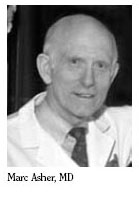 In addition to attempting to alter
resident rotations to improve education,
our teaching program continues as
it has in the past. Monday and Tuesday
we have Basic Science, Pediatric
Orthopaedics or Fracture Conference;
Thursday is Chief’s Conference and
Friday is Fellows’ Conference. Grand
Rounds occurs every Wednesday. In
addition to the normal teaching program,
The Grice Lecture was held on
November 6, 2006. Marc Asher, a distinguished alumnus of
this program was the 20th David Grice Visiting Professor. Dr.
Asher completed the program here at Children’s in 1970 and
went on to become Department Chairman and Professor at the
University of Kansas Medical School and a distinguished spine
surgeon nationally and internationally. He spoke on many
aspects of scoliosis and the development of instrumentation
systems for spinal deformity correction.
In addition to attempting to alter
resident rotations to improve education,
our teaching program continues as
it has in the past. Monday and Tuesday
we have Basic Science, Pediatric
Orthopaedics or Fracture Conference;
Thursday is Chief’s Conference and
Friday is Fellows’ Conference. Grand
Rounds occurs every Wednesday. In
addition to the normal teaching program,
The Grice Lecture was held on
November 6, 2006. Marc Asher, a distinguished alumnus of
this program was the 20th David Grice Visiting Professor. Dr.
Asher completed the program here at Children’s in 1970 and
went on to become Department Chairman and Professor at the
University of Kansas Medical School and a distinguished spine
surgeon nationally and internationally. He spoke on many
aspects of scoliosis and the development of instrumentation
systems for spinal deformity correction.
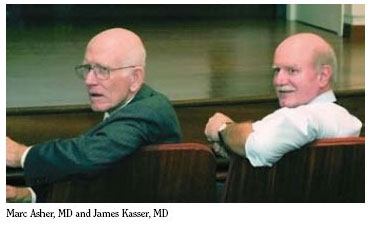 This spring, we had a fantastic Basic Science Program in
Bone Metabolism as a festschrift for Dr. Melvin Glimcher, who
is stepping down at the Director of the Laboratory for Skeletal
Disorders. The program included the portrait of Dr. Glimcher in
honor of his distinguished career and program below outlines
the scientific program held in his honor. The scientific program
included trainees, distinguished prior members of the lab, as
well as national research colleagues
of Dr. Glimcher’s. The
lecturers explored the range of
bone research from mineralization
and structure through
genetics. Dr. Glimcher had a
47-year distinguished record of
continuous NIH funding for his
insights into bone mineralization
as well as its collagenous
This spring, we had a fantastic Basic Science Program in
Bone Metabolism as a festschrift for Dr. Melvin Glimcher, who
is stepping down at the Director of the Laboratory for Skeletal
Disorders. The program included the portrait of Dr. Glimcher in
honor of his distinguished career and program below outlines
the scientific program held in his honor. The scientific program
included trainees, distinguished prior members of the lab, as
well as national research colleagues
of Dr. Glimcher’s. The
lecturers explored the range of
bone research from mineralization
and structure through
genetics. Dr. Glimcher had a
47-year distinguished record of
continuous NIH funding for his
insights into bone mineralization
as well as its collagenous
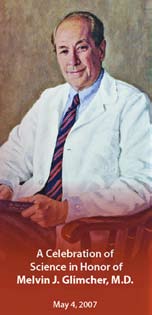 and non-collagen proteins. His
continued work within the lab as
well as insights into the crystal
structure and phosphoproteins
of bone will complement the
molecular genetic emphasis,
which we are now pursuing in
the lab.
and non-collagen proteins. His
continued work within the lab as
well as insights into the crystal
structure and phosphoproteins
of bone will complement the
molecular genetic emphasis,
which we are now pursuing in
the lab.
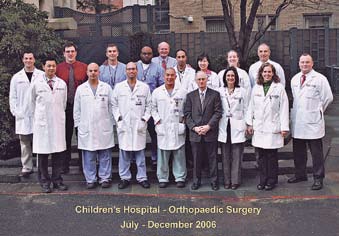 Resident and fellow education remains central to our mission.
In addition to the six Harvard PGY-3 residents on the
service at any time, one Lenox Hill resident and one Dartmouth
resident rotate at our institution. The Dartmouth affiliation is
new this year and we are proud of this association. Our regional
affiliation is complemented by this educational endeavor. Drs.
Moen and Carney at Dartmouth provide three months of pediatric
orthopaedic education for each resident and we provide
three months. The educational integration complements the
clinical relationship established between our institutions.
Resident and fellow education remains central to our mission.
In addition to the six Harvard PGY-3 residents on the
service at any time, one Lenox Hill resident and one Dartmouth
resident rotate at our institution. The Dartmouth affiliation is
new this year and we are proud of this association. Our regional
affiliation is complemented by this educational endeavor. Drs.
Moen and Carney at Dartmouth provide three months of pediatric
orthopaedic education for each resident and we provide
three months. The educational integration complements the
clinical relationship established between our institutions.
In the spring of this year the EPOS Traveling Fellows, Ola
Wiig from Norway, Boyan Valentinov from Bulgaria and Andrzej
Grzegorzewski from Poland visited Children’s Hospital. Our
program consisted of case presentation and discussion, short
papers, and most importantly, social contact at dinners. POSNA
and EPOS have exchange fellow programs every other year. A
number of our prior alumni have participated in this fellowship
program and benefited educationally from this opportunity.

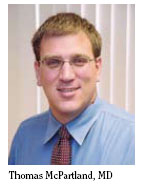 After ACGME review, our fellowship program in Pediatric
Orthopaedics was accredited for five years. We continue to attract
top notch fellows in Pediatric Orthopaedics, as we do in Sports,
Hand Surgery, and Tumor Surgery.
The three pediatric orthopaedic fellows
this year are Tom McPartland, Scott
Rosenfeld, and Jennifer Ty. Thomas
McPartland is a graduate of Robert
Wood Johnson Orthopaedic Program
and after completing the fellowship,
plans to return to New Jersey and enter
practice with Drs. Bowe, Laufer and
Therrien, well known to our institution.
After ACGME review, our fellowship program in Pediatric
Orthopaedics was accredited for five years. We continue to attract
top notch fellows in Pediatric Orthopaedics, as we do in Sports,
Hand Surgery, and Tumor Surgery.
The three pediatric orthopaedic fellows
this year are Tom McPartland, Scott
Rosenfeld, and Jennifer Ty. Thomas
McPartland is a graduate of Robert
Wood Johnson Orthopaedic Program
and after completing the fellowship,
plans to return to New Jersey and enter
practice with Drs. Bowe, Laufer and
Therrien, well known to our institution.
Scott Rosenfeld, a graduate of Texas
Southwestern Residency Program,
where his pediatric orthopaedics was
done with Tony Herring and company,
will go to Houston, Texas and work
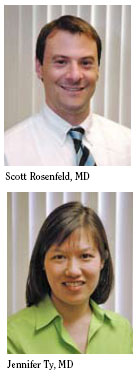 as an attending in the orthopaedic
program at Texas Children’s Hospital
with Jake Weinberg, one of our previous
fellows. Jen Ty, the third fellow, is
a graduate of the Harvard Combined
Orthopaedic Program and will enter
the UCSF Hand Program, to pursue
a career in pediatric hand surgery in
the future.
as an attending in the orthopaedic
program at Texas Children’s Hospital
with Jake Weinberg, one of our previous
fellows. Jen Ty, the third fellow, is
a graduate of the Harvard Combined
Orthopaedic Program and will enter
the UCSF Hand Program, to pursue
a career in pediatric hand surgery in
the future.
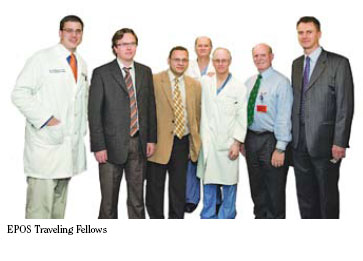 On a personal note, I have been
rather busy with an array of activities
ranging from the Children’s
Hospital Physicians’ Organization to
the American Board of Orthopaedic
Surgery. I am now in charge of the
recertification written examination,
which appears to be a bit of a challenge, as you might guess.
Maintaining the proper balance of questions representing basic
knowledge that all orthopaedic surgeons should have is not a
simple task. Ensuring that satisfactory images are present on
the computers for the exams is probably the biggest challenge.
I am completing my thirteenth year as Orthopaedic
Surgeon-in-Chief at Children’s Hospital. The challenges remain
great. Continued clinical growth with staff development,
clinical and basic science research, and education all must be
emphasized and balanced; I believe that we are succeeding
in these areas as well as growing clinical research under our
Clinical Effectiveness Unit led by Patty Connell, working with
five research assistants. We encourage residents and fellows to
participate actively in research during their time at Children’s.
Our publication rate remains excellent. Staff is being promoted
at a satisfactory rate.
On a personal note, I have been
rather busy with an array of activities
ranging from the Children’s
Hospital Physicians’ Organization to
the American Board of Orthopaedic
Surgery. I am now in charge of the
recertification written examination,
which appears to be a bit of a challenge, as you might guess.
Maintaining the proper balance of questions representing basic
knowledge that all orthopaedic surgeons should have is not a
simple task. Ensuring that satisfactory images are present on
the computers for the exams is probably the biggest challenge.
I am completing my thirteenth year as Orthopaedic
Surgeon-in-Chief at Children’s Hospital. The challenges remain
great. Continued clinical growth with staff development,
clinical and basic science research, and education all must be
emphasized and balanced; I believe that we are succeeding
in these areas as well as growing clinical research under our
Clinical Effectiveness Unit led by Patty Connell, working with
five research assistants. We encourage residents and fellows to
participate actively in research during their time at Children’s.
Our publication rate remains excellent. Staff is being promoted
at a satisfactory rate.
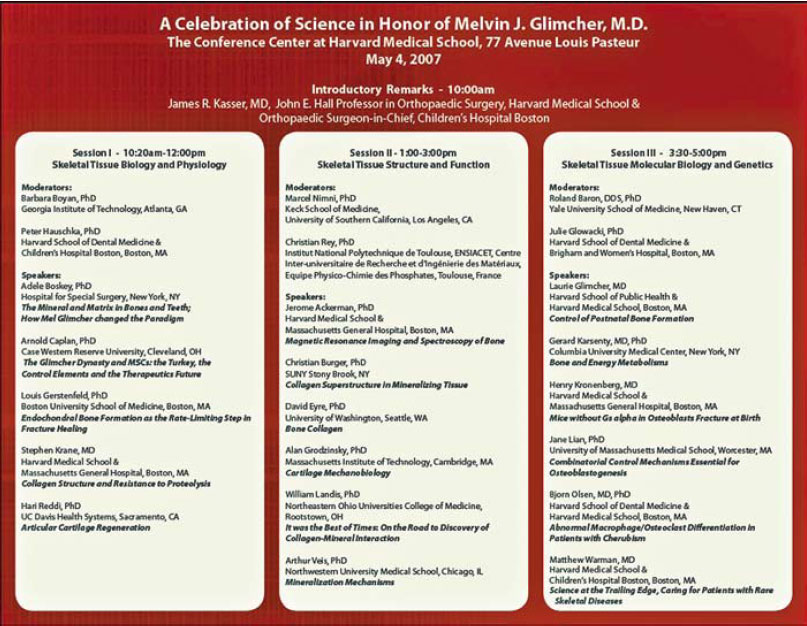
|
|

